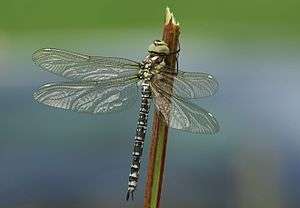Southern hawker
| Southern hawker | |
|---|---|
 | |
| Male, Germany | |
 | |
| Female | |
| Scientific classification | |
| Kingdom: | Animalia |
| Phylum: | Arthropoda |
| Subphylum: | Hexapoda |
| Class: | Insecta |
| Order: | Odonata |
| Suborder: | Anisoptera |
| Family: | Aeshnidae |
| Genus: | Aeshna |
| Species: | A. cyanea |
| Binomial name | |
| Aeshna cyanea (Müller, 1764) | |
The southern hawker or blue hawker (Aeshna cyanea) is a 70 millimetres (2.8 in) long species of hawker dragonfly.The species is one of the most common and most widespread dragonflies in Europe. The total range is West Palearctic and covers a large part of Europe (to Scotland and southern Scandinavia in the North to Italy (without the Southwest) and the northern Balkans to the South); the Eastern boundary is formed by the Ural and the West by Ireland. It is also found in Northwest Africa (Algeria). In Central Europe the species is very common
It is large, with a long body. It has green markings on the black bodies, and the male also has blue spots on the abdomen.
The southern hawker breeds in still or slow-flowing water, but will wander widely, and is often seen in gardens and open woodland. This is an inquisitive species and will approach people.
The adult eats various insects, caught on the wing. The nymphs feed on aquatic insects, tadpoles and small fish ambushed in the pond they frequent until they emerge as adults in July and August after three years’ development.
Behaviour
This is a large, brightly coloured dragonfly. The males are often seen patrolling by a ponds edge or river, where they fight away intruders, crashing into rival males and spiralling through the air. The females are quite inconspicuous when they lay their eggs, but they sometimes give away their spot by clattering up from the reeds.
Larvae
The eggs are laid by jabbing the abdomen into rotting vegetation or wood. The eggs hatch in the spring, after being laid in the previous summer or autumn. The larvae live on small tadpoles and invertebrates. They emerge after 2–3 years.
See also
References
- ↑ Boudot, J.-P. (2014). "Aeshna cyanea". IUCN Red List of Threatened Species. Version 2014.2. International Union for Conservation of Nature. Retrieved 29 August 2014.
- "Aeshna cyanea". British Dragonfly Society. Retrieved 17 August 2010.
External links
![]() Data related to Aeshna cyanea at Wikispecies
Data related to Aeshna cyanea at Wikispecies
![]() Media related to Aeshna cyanea at Wikimedia Commons
Media related to Aeshna cyanea at Wikimedia Commons
Gallery
 Female ovipositing
Female ovipositing- Female freshly emerged with larva skin
 Female
Female- Male
_immature_male.jpg) Immature male
Immature male.jpg) Immature female
Immature female Two stages in emergence from nymph-cuticle
Two stages in emergence from nymph-cuticle Adult emerged, wings expanding
Adult emerged, wings expanding With expanded wings
With expanded wings_-_Larve_1.jpg) Larva
Larva In flight
In flight

